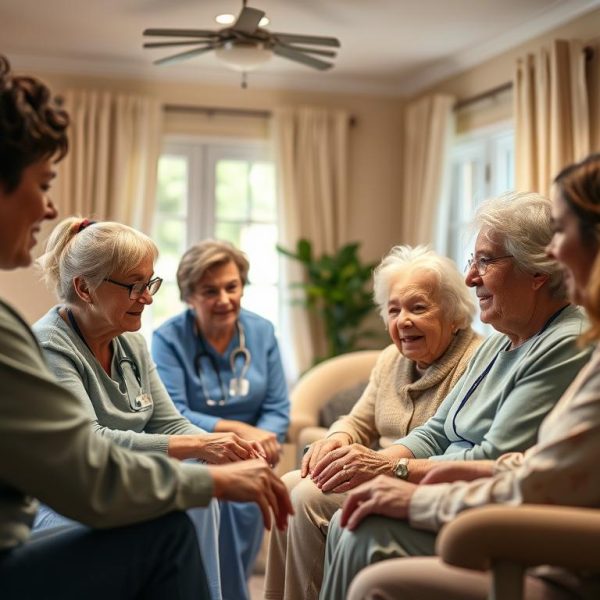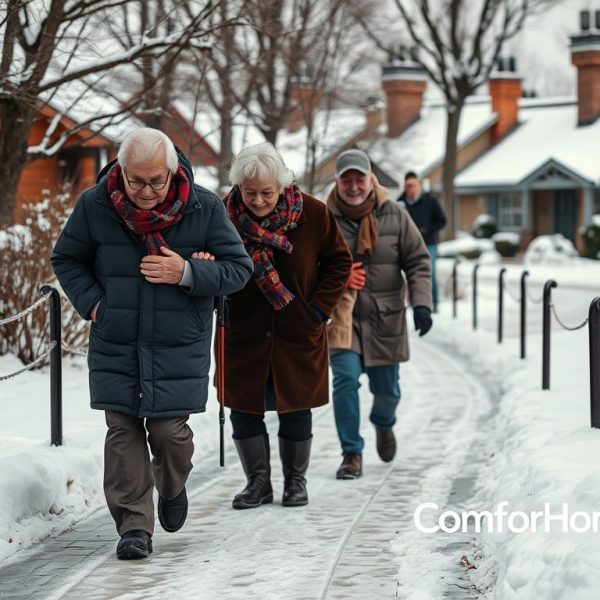Are you concerned about the quality of care your elderly loved ones receive? Family dynamics play a crucial role in shaping senior patient outcomes, and understanding this connection can unlock better care for older adults.
In this comprehensive guide, we’ll explore 7 ways family relationships impact senior health and well-being. From emotional support to treatment adherence, we’ll delve into the vital role family members play in enhancing the quality of life for older adults.
Discover how:
• Positive family dynamics can boost physical and mental health
• Effective communication bridges gaps between patients, families, and healthcare providers
• Family involvement in treatment decisions leads to more patient-centered care
• Strong support systems reduce social isolation and improve health outcomes
Whether you’re a caregiver, adult child, or healthcare professional, this blog will provide valuable insights to help you navigate the complex world of senior care. Let’s explore how family dynamics can be leveraged to create better health outcomes for our aging loved ones.
The Crucial Role of Family Dynamics in Senior Care
Family dynamics play a vital role in shaping the care experience for older adults. When a family member steps into the role of caregiver, they become an integral part of the healthcare team.
Consider the case of Sarah, whose 80-year-old father was recently diagnosed with Alzheimer’s. As his primary caregiver, Sarah’s relationship with her father dramatically influences his daily life and overall well-being.
Healthcare providers recognize the crucial role that family members play in senior care. They often work closely with families to ensure the best possible outcomes for older adults.
For instance, Dr. Johnson, a geriatrician, always includes family members in her consultations. She believes that understanding family dynamics is key to providing effective care.
“Family relationships can either be a source of strength or stress for seniors,” Dr. Johnson explains. “Our job as healthcare providers is to harness the positive aspects and mitigate the negative ones.”
The impact of family dynamics extends beyond emotional support. It influences treatment adherence, lifestyle choices, and even the effectiveness of medical interventions.
Take the case of the Martinez family. When grandpa Martinez was diagnosed with diabetes, the whole family rallied around him. They adjusted their eating habits, joined him on daily walks, and helped monitor his blood sugar levels.
This collective effort not only improved grandpa Martinez’s health but also strengthened family bonds.
On the flip side, strained family relationships can hinder care. A study by the National Institute on Aging found that seniors with poor family support were more likely to experience depression and slower recovery from illnesses.
Understanding these dynamics allows healthcare providers to tailor their approach. They can identify potential support systems or address family-related stressors that might affect the patient’s health.
💡 Key Takeaways: Family dynamics significantly influence senior care outcomes, making it essential for healthcare providers to consider and leverage these relationships in treatment plans.
Emotional Support: A Pillar of Senior Patient Well-being
Emotional support from family members is a cornerstone of senior patient well-being. It impacts both mental health and physical health in profound ways.
Imagine Emma, a 75-year-old widow recovering from hip surgery. Her daughter visits daily, bringing homemade meals and cheerful conversation. This simple act of care enhances Emma’s quality of life, speeding up her recovery.
Research backs this up. A study in the Journal of Gerontology found that seniors with strong emotional support had 22% lower mortality rates over a 7-year period.
But what does effective emotional support look like? It’s more than just being present. It involves:
1. Active listening
2. Validating feelings
3. Offering encouragement
4. Providing companionship
5. Helping with daily tasks
For instance, when Bob’s wife was diagnosed with Parkinson’s, he learned to be patient and understanding. He would hold her hand during doctor’s visits, celebrating small victories and providing a steady presence during tough days.
This level of support doesn’t just make seniors feel better emotionally. It has tangible effects on physical health too.
Dr. Lisa Chen, a geriatrician, explains: “Emotional support reduces stress hormones like cortisol. This, in turn, boosts immune function and can even lower blood pressure.”
However, it’s crucial to strike a balance. Overprotective family members might inadvertently hinder a senior’s independence. The goal is to provide support while encouraging autonomy.
Social support extends beyond immediate family. Friends, neighbors, and community groups can all play a part in a senior’s support network.
Take the case of George, an 82-year-old widower. His son lives out of state, but George’s neighbors check on him regularly. They invite him for dinners, help with yard work, and even taught him how to use video chat to stay connected with his family.
💡 Key Takeaways: Emotional support from family and social networks significantly enhances seniors’ mental and physical health, leading to better overall well-being and improved health outcomes.
The Impact of Positive Family Relationships on Recovery
Positive family relationships can be a powerful catalyst for recovery in senior patients. A strong, healthy family dynamic can make all the difference in a senior’s healing journey.
Consider the case of the Thompson family. When Grandma Thompson suffered a stroke, her recovery was significantly influenced by her family’s support.
Her children took turns staying with her at the hospital, ensuring she was never alone. They engaged her in conversation, helping her regain her speech skills. Her grandchildren brought her favorite books and music, lifting her spirits.
This nurturing environment, created by positive family relationships, accelerated Grandma Thompson’s recovery. Her doctors noted that her progress was faster than average for patients her age.
Research supports this anecdotal evidence. A study in the Journal of the American Heart Association found that stroke survivors with strong family support had better functional outcomes and lower depression rates.
But it’s not just about major health events. Day-to-day life is also impacted by family dynamics. Seniors in happy marriages or with close-knit families often report better overall health and life satisfaction.
For example, Mr. and Mrs. Chen, married for 50 years, support each other in maintaining healthy lifestyles. They cook nutritious meals together, remind each other to take medications, and enjoy daily walks in the park.
💡 Key Takeaways: Positive family relationships significantly enhance senior patients’ recovery processes and overall health, highlighting the importance of nurturing strong family bonds in senior care.
Open Communication: Bridging Gaps in Senior Healthcare
Effective communication is the bridge that connects seniors, their families, and healthcare professionals. It’s the key to ensuring everyone is on the same page regarding the senior’s health and care.
Consider the case of the Wilson family. When 78-year-old Mr. Wilson was diagnosed with heart disease, his children were initially overwhelmed. However, their family doctor, Dr. Thompson, encouraged open communication.
Dr. Thompson organized a family meeting where Mr. Wilson’s treatment plan was discussed in detail. She explained medical terms in simple language and encouraged questions from everyone.
This approach made Mr. Wilson feel like an active participant in his own care. His children felt more confident in supporting their father, knowing exactly what his care entailed.
Open communication also helps in identifying and addressing potential issues early. For instance, Mrs. Garcia’s family noticed she was becoming increasingly forgetful. Instead of dismissing it as “just old age,” they discussed their concerns with her primary care physician.
This led to an early diagnosis of mild cognitive impairment, allowing for timely interventions that significantly improved Mrs. Garcia’s quality of life.
However, achieving effective communication isn’t always easy. It requires effort from all parties involved. Here are some key elements:
1. Active listening
2. Clear, jargon-free explanations
3. Regular check-ins
4. Respect for the senior’s autonomy
5. Inclusion of all relevant family members
Healthcare professionals play a crucial role in facilitating this communication. Many hospitals now have dedicated programs to improve family-provider communication.
For example, Memorial Hospital implemented a “Family Rounds” program. Here, doctors conduct their daily patient visits with family members present, encouraging questions and discussions.
Remember, communication is a two-way street. Seniors and their families should feel empowered to ask questions, express concerns, and seek clarifications from healthcare providers.
💡 Key Takeaways: Open and effective communication between seniors, their families, and healthcare professionals is crucial for comprehensive care, leading to better health outcomes and increased patient satisfaction.
Strategies for Improving Family-Provider Communication
Improving communication between families and healthcare providers is crucial for effective senior care. Here are some strategies to enhance this vital interaction:
1. Use plain language: Healthcare professionals should avoid medical jargon and explain concepts in simple terms.
2. Encourage questions: Create an environment where families feel comfortable asking for clarifications.
3. Utilize technology: Many healthcare systems now offer patient portals or apps for easy communication.
4. Implement family meetings: Regular meetings can keep everyone informed and aligned on care goals.
5. Engage social workers: They can act as mediators, helping translate medical information to families.
For instance, St. Mary’s Hospital implemented a CCM (Chronic Care Management) program. This initiative assigns a dedicated nurse to each senior patient, serving as a point of contact for families and coordinating communication with various healthcare providers.
💡 Key Takeaways: Implementing structured communication strategies can significantly improve family-provider interactions, leading to better coordinated and more effective senior care.
Family Involvement in Treatment Decisions and Care Planning
Family involvement in treatment decisions and care planning is a cornerstone of patient-centered care for seniors. When families are actively engaged, it can lead to more comprehensive care plans and better health outcomes.
Consider the case of Mr. Johnson, a 75-year-old with multiple chronic conditions including diabetes and heart disease. His adult children, Sarah and Mike, were deeply involved in his care planning.
During a care conference with Mr. Johnson’s healthcare provider, Sarah raised concerns about her father’s increasing forgetfulness. This led to a cognitive assessment, revealing early signs of dementia. Without Sarah’s input, this issue might have gone unnoticed for months.
Mike, on the other hand, shared insights about their father’s dietary preferences and daily routines. This information helped the healthcare team tailor a more realistic and sustainable treatment plan.
Family involvement is particularly crucial when dealing with chronic conditions. Dr. Emily Chen, a geriatrician, explains: “Chronic conditions require ongoing management. Family members, who see the patient daily, can provide valuable insights that we might miss during short clinic visits.”
However, it’s important to strike a balance. While family input is valuable, the senior patient should remain the central decision-maker when possible. Healthcare providers must ensure that the patient’s wishes are respected and that family involvement doesn’t overshadow the patient’s autonomy.
Some effective ways to involve family in care planning include:
1. Inviting family members to medical appointments
2. Including them in discussions about treatment options
3. Educating them about the patient’s conditions and care needs
4. Assigning specific roles in the care plan
5. Regularly updating them on the patient’s progress
Many healthcare systems now offer family education programs. For instance, Sunshine Hospital runs a “Family Care Partner” program, where family members of seniors with chronic conditions receive training on disease management, medication administration, and recognizing warning signs.
Remember, every family is unique. Some may want to be heavily involved, while others might prefer a more hands-off approach. Healthcare providers should be flexible and adapt their approach to each family’s preferences and dynamics.
💡 Key Takeaways: Active family involvement in treatment decisions and care planning leads to more comprehensive and effective care for senior patients, but it’s crucial to maintain a balance that respects the patient’s autonomy.
Navigating Healthcare Systems Together
Navigating the complex healthcare system can be daunting for seniors. This is where family support becomes invaluable.
Consider the case of Mrs. Rodriguez, an 80-year-old with arthritis. Her granddaughter, Elena, helps her manage doctor appointments, understand insurance claims, and coordinate between different specialists.
Here’s how families can help:
1. Attend appointments: Family members can take notes and ask questions.
2. Manage paperwork: Help with insurance forms and medical bills.
3. Coordinate care: Ensure different healthcare providers are on the same page.
4. Research options: Look into various treatment options or specialists.
5. Build a social network: Connect with support groups or community resources.
For instance, when Mr. Patel needed a hip replacement, his son researched different surgeons, compared hospital ratings, and even connected with other patients through online forums.
Many hospitals now offer patient navigator services to help families. These professionals can guide families through the healthcare system, explaining processes and connecting them with necessary resources.
💡 Key Takeaways: Family support in navigating healthcare systems can significantly improve the care experience for seniors, ensuring they receive comprehensive and coordinated care.
The Impact of Family Support on Treatment Adherence
Family support plays a crucial role in ensuring seniors adhere to their treatment plans, particularly for those managing chronic illnesses. When family members are involved, seniors are more likely to take medications as prescribed, follow dietary guidelines, and maintain necessary lifestyle changes.
Take the case of Mr. Thompson, a 72-year-old with type 2 diabetes. Initially, he struggled to maintain his blood sugar levels and often forgot to take his medication. His daughter, Sarah, stepped in to help.
Sarah set up a medication reminder system on her father’s phone. She also learned about diabetic-friendly cooking and started preparing meals for him twice a week. Additionally, she invited her father for daily evening walks.
Within three months, Mr. Thompson’s blood sugar levels stabilized, and his overall health improved significantly. His doctor noted that this turnaround was largely due to improved treatment adherence, facilitated by family support.
Research backs this up. A study in the Journal of Gerontology found that seniors with strong family support were 30% more likely to adhere to their medication regimens compared to those without such support.
Family support can impact treatment adherence in several ways:
1. Reminders: Family members can remind seniors to take medications or attend appointments.
2. Education: They can help seniors understand their conditions and the importance of treatment.
3. Motivation: Encouragement from loved ones can boost a senior’s commitment to their health.
4. Practical help: Assistance with transportation to medical appointments or picking up prescriptions.
5. Monitoring: Family members can watch for side effects or changes in condition.
However, it’s important to strike a balance. Over-involvement can sometimes lead to resistance. Dr. Lisa Chen, a geriatrician, advises: “The goal is to support, not control. Encourage independence while providing necessary assistance.”
Physical activity is another area where family support can make a big difference. When family members join in, it becomes more enjoyable and sustainable for seniors.
For instance, the Garcia family started a “Sunday Family Fitness” tradition. Every week, they try a new physical activity together – from gentle yoga to nature walks. This not only improved Grandpa Garcia’s physical health but also strengthened family bonds.
Social influence from family can also impact health behaviors. When adult children model healthy eating habits or quit smoking, it can motivate seniors to make similar positive changes.
💡 Key Takeaways: Strong family support significantly enhances treatment adherence in seniors, leading to better health outcomes and improved management of chronic conditions.
Reducing Isolation through Family Engagement
Social isolation is a significant concern for many seniors, often leading to deteriorating physical and mental health. Family engagement can play a crucial role in combating this issue.
Consider Mrs. Johnson, an 85-year-old widow living alone. Her children implemented a “family connection” schedule:
1. Daily phone calls
2. Weekly video chats with grandchildren
3. Monthly family dinners
4. Quarterly outings to community events
This regular engagement significantly improved Mrs. Johnson’s mood and cognitive function.
Community support can extend family efforts. Local senior centers often offer programs that families can participate in together. For instance, the “Grandparents and Me” art classes at the local community center became a favorite activity for the Williams family.
Remember, reducing isolation isn’t just about physical presence. It’s about meaningful connection and making elderly individuals feel valued and included in family life.
💡 Key Takeaways: Regular and meaningful family engagement can significantly reduce social isolation in seniors, leading to improved mental and physical health outcomes.
Creating a Strong Support System: Assigning Family Roles
Creating a robust support system for seniors often involves assigning specific roles to family members. This approach ensures comprehensive care while preventing burnout of any single caregiver.
Let’s look at the Martinez family. When Grandpa Martinez was diagnosed with Parkinson’s, the family came together to create a care plan:
1. Maria (daughter): Primary caregiver and medication manager
2. Carlos (son): Handles finances and insurance matters
3. Elena (granddaughter): Tech support and social media connector
4. Luis (grandson): Weekly grocery shopping and home maintenance
5. Sophia (daughter-in-law): Coordinates medical appointments and transportation
This division of responsibilities ensures Grandpa Martinez receives well-rounded care without overwhelming any single family member.
It’s important to consider each family member’s strengths, schedules, and geographic proximity when assigning roles. For instance, Elena, being tech-savvy, set up a shared digital calendar for the family to coordinate care tasks.
Home care can be integrated into this system. Many families hire professional caregivers to fill gaps or provide respite care. The key is to view these professionals as part of the extended care team.
Community support can also play a vital role. The Martinez family connected with a local Parkinson’s support group, expanding their social network and access to resources.
Remember, family relationships should not be reduced to caregiving roles. It’s crucial to maintain the emotional bonds that make family special.
For example, while Luis helps with practical tasks, he also makes sure to spend quality time with his grandfather, listening to his stories and playing chess – activities they’ve always enjoyed together.
💡 Key Takeaways: Assigning specific roles to family members creates a comprehensive and sustainable care system for seniors, integrating professional help and community support when needed.
Conclusion
As we’ve explored the intricate web of family dynamics and their profound impact on senior patient outcomes, it’s clear that the role of family in healthcare is both powerful and multifaceted. From providing emotional support to enhancing communication with healthcare providers, family involvement can significantly boost health outcomes for older adults. By fostering strong relationships, creating a supportive environment, and actively participating in care decisions, families can unlock better care for their loved ones.
Remember, every family is unique, and tailoring approaches to individual needs is crucial. Whether it’s addressing chronic conditions, promoting physical activity, or navigating the healthcare system, the power of a united family can make a world of difference. As you move forward, consider how you can strengthen your family dynamics to improve the quality of life for your senior loved ones. By implementing the strategies discussed, you’re not just providing care; you’re creating a foundation for enhanced well-being and happier, healthier golden years.








